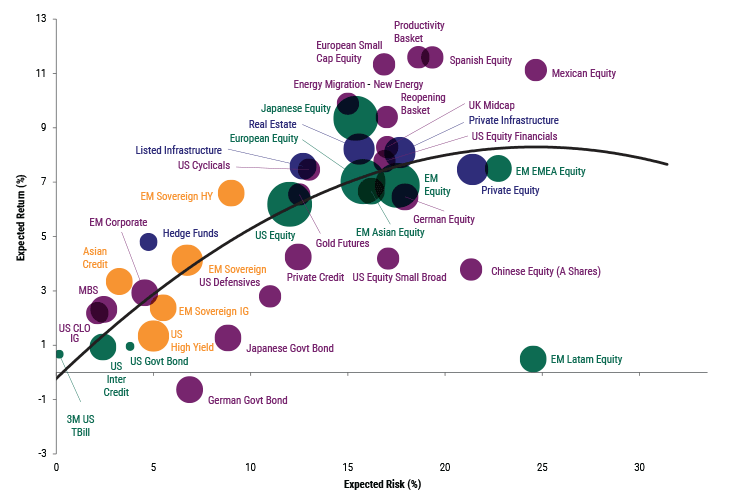How should responsible investors respond when below-zero oil prices present an upside opportunity, but aligning with environmental, social, and governance (ESG) investment principles is paramount? For our Multi-Asset team, addressing the oil price shock in the spring of 2020 was an exercise in ingenuity – and gave rise to an innovative solution that advanced sustainability principles while adding to potential returns. Here’s how our “Energy Evolution Basket” was born, and how it works.
The challenge: exploiting negative oil prices while aligning with sustainability principles
As a result of changing public attitudes, sustainable investment leadership, and evolving regulations, the movement to cleaner, renewable, and non-carbon-based energy sources is well underway. Yet while urgency is essential, this movement is not linear. The economic basics of supply and demand, along with political decisions and other factors, can contribute to short-term conditions that hinder the transition to alternative energy and present challenges to investors.
One such challenge emerged as the Covid pandemic took hold in the spring of 2020, when the price of West Texas Intermediate (WTI) crude oil futures fell below zero. With lockdowns bringing about a sudden halt to the economy, the lead time necessary to bring oil supply in line with sharply reduced demand, paired with a lack of sufficient oil storage facilities, meant oil was more than just amazingly cheap — users were effectively being paid to take it. How could investors faced with this opportunity further their sustainability objectives while also profiting from their commitment?
The solution: our Energy Evolution Basket
When oil prices turned negative, PineBridge believed the anomaly wouldn’t last, and that time was of the essence to minimize potential damage to the transition to cleaner energy sources. Other investors agreed, as indicated by the slim decline in the price of US energy stocks. But in markets with shorter time horizons, prices did plummet. In fact, oil futures looked especially underpriced given the assumption that supply and demand for the commodity would slowly, but inevitably, return to a more normal balance.
Seeing an opportunity for short-term gains as oil fell below zero while more importantly advancing the transition to alternative energy sources, PineBridge’s Multi-Asset team mobilized to create an Energy Evolution Basket — buying primarily oil futures contracts, but at the same time assembling a toehold in a group of stocks poised to benefit from the movement toward renewable energy.
The intuition behind the Energy Evolution Basket was that very high oil prices are needed to help speed along the energy transition and decarbonize our energy supplies. Prices below an energy-migration-neutral level, which we placed at about US$30/barrel, would outright blunt the transition to new energy. For example, while the upfront costs of electric cars can be substantially higher than for traditional cars, the savings on gas can allow buyers to recoup the upfront costs over time. Yet when oil falls to very low levels, the economics no longer favor electric vehicles.
With an eye to future market moves, the approach we devised was to support the oil price when it fell below the migration-neutral level, with an eye toward decreasing this exposure as prices went back above this level (and to completely eliminate the position as oil prices hit replacement cost), using the proceeds to fund more purchases of renewable energy stocks.
This innovative response allowed investors to help push energy prices back to levels that would accelerate (rather than slow) the development of cleaner energy sources while also capturing the initial recovery in crude prices, with profits ultimately financing larger positions and greater support for newer forms of energy.
The impact, and what lies ahead
The team closed out oil futures positions (purchased when prices were negative) later in 2020, when oil rose above the migration-neutral level into the low 30s to low 40s. Today, the basket invests purely in publicly traded companies with revenues associated with wind, solar, or other sources of renewable energy, or with components related to the transmission or storage of power generated by those sources. Yet should energy prices experience another temporary drop below the energy-migration-neutral price, driven by short-term changes in supply and demand, the team stands ready to reinitiate a position in oil futures.
We believe high oil prices are necessary to maintain the momentum toward cleaner energy, and that this transition is especially urgent given the growing effects of global warming. In the interim, like other like-minded sustainable investors, we’re actively engaging with hydrocarbon companies to funnel added cash flow generated during high-price periods toward investments in sustainable energy rather than into further hydrocarbon exploration.
We believe the Energy Evolution Basket has attractive risk/return characteristics driven by the structural transition toward new energy over the coming five years, as illustrated in our Capital Market Line (a forecast of the relative risk/return profile over a five-year period across asset classes).
Capital Market Line as of 30 June 2021 (USD View, Unhedged)

While the Energy Evolution Basket was a response to a point-in-time challenge and opportunity, it has the flexibility to adapt as market conditions change – all while maintaining a focus on sustainability.

